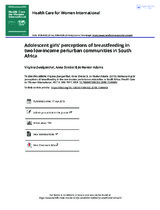| dc.contributor.author | Zweigenthal, Virginia | |
| dc.contributor.author | Strebel, Anna | |
| dc.contributor.author | Hunter-Adams, Jo | |
| dc.date.accessioned | 2021-06-22T09:21:30Z | |
| dc.date.available | 2021-06-22T09:21:30Z | |
| dc.date.issued | 2019 | |
| dc.identifier.citation | Zweigenthal, V.et al.(2019). Adolescent girls’ perceptions of breastfeeding in two low-income periurban communities in South Africa. Health Care for Women International, 40(7–9), 995–1011. https://doi.org/10.1080/07399332.2018.1549043 | en_US |
| dc.identifier.issn | 1096-4665 | |
| dc.identifier.uri | https://doi.org/10.1080/07399332.2018.1549043 | |
| dc.identifier.uri | http://hdl.handle.net/10566/6328 | |
| dc.description.abstract | In South Africa, exclusive breastfeeding rates are low, and
rates of teenage pregnancy are high. Educational policy enables mothers’ return to school, which conflicts with policy
emphasizing exclusive breastfeeding. We elicited adolescent
women’s perceptions and experiences of infant feeding
choices, and conducted six focus groups (N ¼ 57) in two periurban settlements. Participants knew arguments in favor of
and against breast and formula-feeding, but in practice, mixed
feeding occurred early after birth. While completion of high
school was emphasized, exclusive breastfeeding was viewed
as impractical. Congruent education policies and infant feeding policies/guidelines must address the constraints and contexts of adolescent mothers. | en_US |
| dc.language.iso | en | en_US |
| dc.publisher | Routledge | en_US |
| dc.subject | Adolescent girls | en_US |
| dc.subject | Breastfeeding | en_US |
| dc.subject | Low-income | en_US |
| dc.subject | South Africa | en_US |
| dc.subject | Teenage pregnancy | en_US |
| dc.title | Adolescent girls’ perceptions of breastfeeding in two low-income periurban communities in South Africa | en_US |
| dc.type | Article | en_US |

